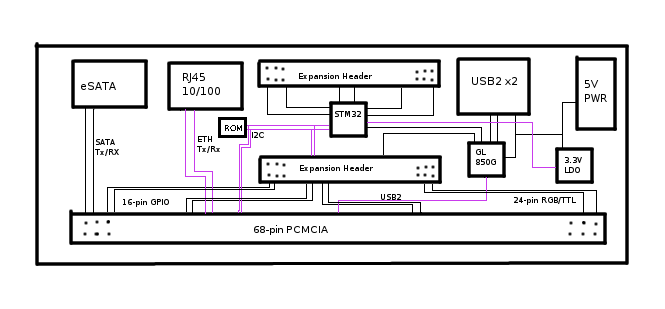Difference between revisions of "Embedded Open Modular Architecture/EOMA68/MiniEngineeringBoard"
m |
(→Micro Board: Engineering, Engineering and Experimentation) |
||
| Line 6: | Line 6: | ||
The Micro Board can therefore be used for several purposes, in combination with the PCMCIA CPU Card: | The Micro Board can therefore be used for several purposes, in combination with the PCMCIA CPU Card: | ||
| + | * SoC Vendor's "Board Support Package" (BSP) Reference Designs | ||
* A Free Software Developer Board, similar to the [http://beagleboard.org Beagleboard] and [http://pandaboard.org Pandaboard] | * A Free Software Developer Board, similar to the [http://beagleboard.org Beagleboard] and [http://pandaboard.org Pandaboard] | ||
* As a stand-alone Board (without the PCMCIA CPU Card) | * As a stand-alone Board (without the PCMCIA CPU Card) | ||
| Line 13: | Line 14: | ||
* An OEM off-the-shelf platform for deployment in Industrial Embedded use. | * An OEM off-the-shelf platform for deployment in Industrial Embedded use. | ||
| − | as well as many other alternative purposes, besides | + | as well as many other alternative purposes, besides these listed here. For examples of potential combined uses of the Micro Engineering Board, it is worthwhile examining these lists: |
| + | * [http://beagleboard.org/project List of BeagleBoard Projects] and [http://pandaboard.org/content/projects List of Pandaboard Projects] for examples of how successful a powerful embedded CPU board can become, on its own. | ||
| + | * [http://www.arduino.cc/playground/Projects/ArduinoUsers List of Arduino Projects] for examples of how successful a low-cost 16mhz CPU can become, even on its own. | ||
| + | * [http://shieldlist.org/ List of Arduino Shields] for examples of off-the-shelf hardware modules that could be leveraged, if the Micro Engineering Board's Expansion Header is made compatible (or even partially compatible). | ||
| + | * [http://en.wikipedia.org/wiki/List_of_Arduino_compatibles] for examples of alternative possibilities to the example Micro Engineering Board described here | ||
| + | |||
| + | The Micro Engineering Board therefore brings together two powerful and flexible concepts into one, to create something that is even more flexible, due to conformance to a simple yet future-proof standard (EOMA/PCMCIA). | ||
= Components and Interfaces = | = Components and Interfaces = | ||
Revision as of 10:00, 18 September 2011
Micro Board: Engineering, Engineering and Experimentation
This board's primary purpose is to provide a wide range of options for experimentation purposes, as well as an Open Platform for Free Software Development. It therefore includes a low-cost on-board ARM Cortex M3 Embedded Controller. A secondary purpose is for the Micro Board to make the development process of in-house designs a smoother and easier prospect.
The STM32F appears to be the best choice, for exactly the same reasons that Olimex chose the STM32F for their Olimexino. In large volume, the STM32F103RBT6 is around $USD 1.00 to 1.50, making it highly cost effective. Alternative Embedded Controllers (for example those from Texas Instruments) are both slower as well as more expensive.
The Micro Board can therefore be used for several purposes, in combination with the PCMCIA CPU Card:
- SoC Vendor's "Board Support Package" (BSP) Reference Designs
- A Free Software Developer Board, similar to the Beagleboard and Pandaboard
- As a stand-alone Board (without the PCMCIA CPU Card)
- An Arduino-like replacement, with or without a PCMCIA CPU Card
- A development platform for ODMs
- A RepRap 3D Printer controller with or without an embedded network-capable CPU Card
- An OEM off-the-shelf platform for deployment in Industrial Embedded use.
as well as many other alternative purposes, besides these listed here. For examples of potential combined uses of the Micro Engineering Board, it is worthwhile examining these lists:
- List of BeagleBoard Projects and List of Pandaboard Projects for examples of how successful a powerful embedded CPU board can become, on its own.
- List of Arduino Projects for examples of how successful a low-cost 16mhz CPU can become, even on its own.
- List of Arduino Shields for examples of off-the-shelf hardware modules that could be leveraged, if the Micro Engineering Board's Expansion Header is made compatible (or even partially compatible).
- [1] for examples of alternative possibilities to the example Micro Engineering Board described here
The Micro Engineering Board therefore brings together two powerful and flexible concepts into one, to create something that is even more flexible, due to conformance to a simple yet future-proof standard (EOMA/PCMCIA).
Components and Interfaces
The Micro-Board's Interfaces comprise:
- EOMA-compliant PCMCIA Connector
- eSATA
- RJ45 for 10/100 Ethernet
- 2x USB2
- 5V Power Socket
- Expansion Header for access to the STM32F's features
- Expansion Header for pass-through access to 24-pin RGB/TTL, I2C and GPIO from the PCMCIA CPU Card
The ICs required include:
- a 4-port USB Hub, connecting the PCMCIA CPU Card and the STM32F
- a 3.3v LDO (and other Power Regulators)
- an STM32F103RBT6
